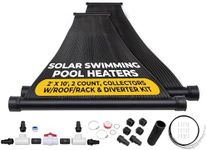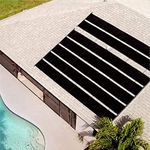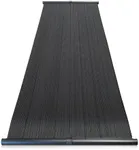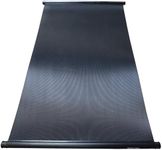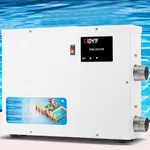Buying Guide for the Best Solar Pool Heaters
Choosing the right solar pool heater can significantly enhance your swimming experience by extending your pool season and maintaining a comfortable water temperature. Solar pool heaters use the sun's energy to heat your pool, making them an eco-friendly and cost-effective option. To find the best fit for your needs, it's important to understand the key specifications and how they impact performance and suitability for your pool.Collector AreaThe collector area refers to the surface area of the solar panels that capture and convert sunlight into heat. This spec is crucial because it determines how much solar energy can be harnessed to heat your pool. Generally, the larger the collector area, the more heat can be generated. For small pools, a collector area of around 50-100 square feet may suffice, while larger pools may require 200-400 square feet or more. To choose the right size, consider the surface area of your pool and the climate in your region. Warmer climates may need less collector area compared to cooler regions.
EfficiencyEfficiency measures how effectively the solar pool heater converts sunlight into usable heat. Higher efficiency means more heat is generated from the same amount of sunlight. Efficiency is typically expressed as a percentage. For example, a solar heater with 80% efficiency will convert 80% of the sunlight it receives into heat. When comparing models, look for higher efficiency ratings, especially if you live in an area with less consistent sunlight. However, even lower efficiency models can be effective in very sunny regions.
Flow RateFlow rate indicates how much water can pass through the solar heater per minute, usually measured in gallons per minute (GPM). This spec is important because it affects how quickly your pool water can be heated. A higher flow rate means more water is being heated at once, which can be beneficial for larger pools. For smaller pools, a lower flow rate may be sufficient. To determine the right flow rate, consider the size of your pool and your desired heating speed. A typical range might be 20-40 GPM for residential pools.
Durability and MaterialsDurability and materials refer to the construction quality of the solar pool heater, including the type of materials used for the panels and other components. This spec is important because it affects the longevity and maintenance needs of the heater. Common materials include plastic, rubber, and metal. Plastic and rubber are often more affordable and resistant to corrosion, while metal components can offer greater durability but may require more maintenance. Choose a solar heater with materials that can withstand your local weather conditions and pool chemicals.
Installation and CompatibilityInstallation and compatibility refer to how easy it is to set up the solar pool heater and whether it can be integrated with your existing pool system. This spec is important because it affects the overall convenience and cost of getting your solar heater up and running. Some models are designed for DIY installation, while others may require professional help. Additionally, ensure that the solar heater is compatible with your pool's pump and filtration system. Consider your own technical skills and the complexity of your pool setup when choosing a model.
WarrantyThe warranty is the manufacturer's guarantee to repair or replace the solar pool heater if it fails within a certain period. This spec is important because it provides peace of mind and protection for your investment. Warranties can range from 1 to 10 years or more. A longer warranty generally indicates greater confidence in the product's durability and performance. When choosing a solar pool heater, look for a model with a warranty that covers a reasonable period, ideally at least 5 years, to ensure you are protected against potential issues.



